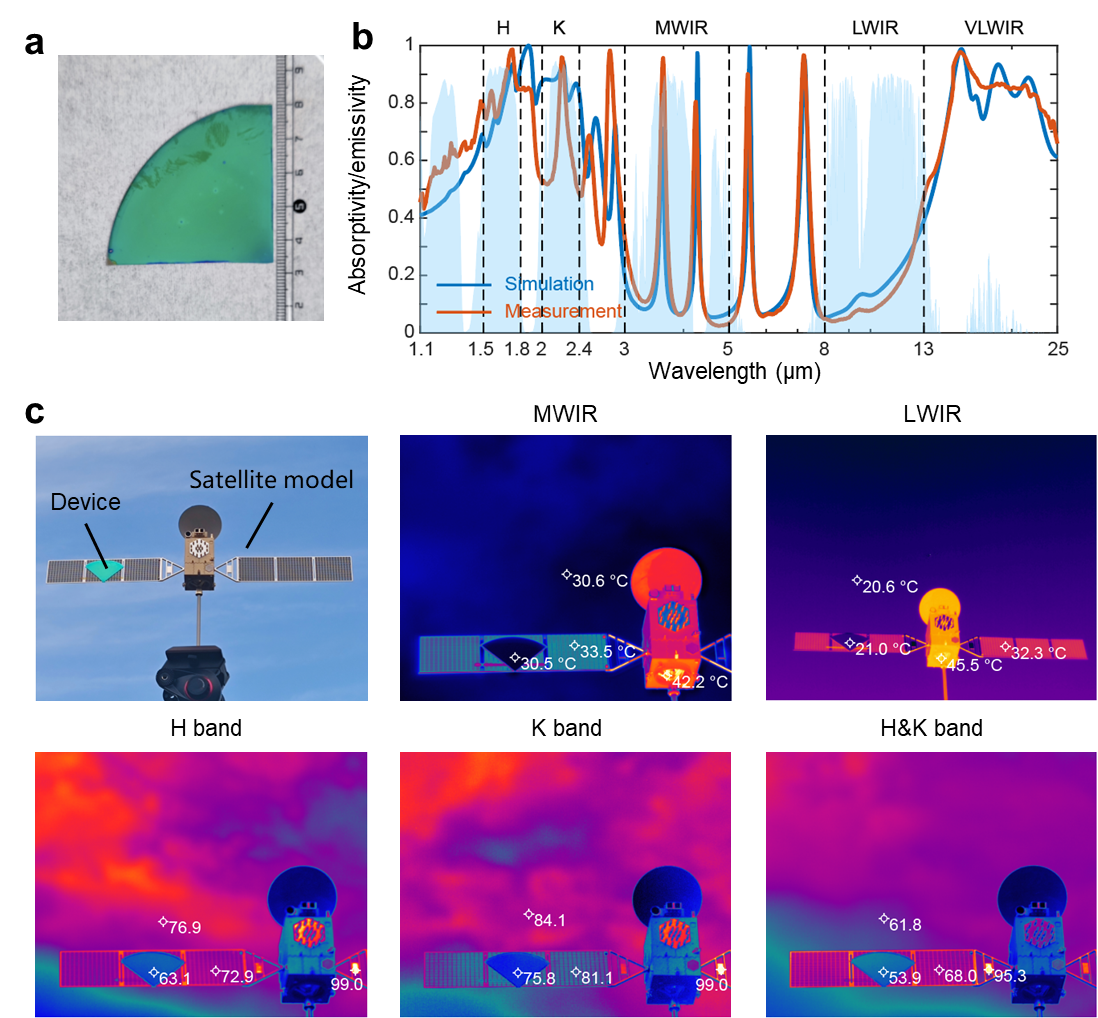Space-to-ground infrared camouflage with radiative heat dissipation
GA, UNITED STATES, April 27, 2025 /EINPresswire.com/ -- With the rapid development of the space industry, enhancing the stealth and survivability of spacecraft has become a critical challenge. Professor Qiang Li's team at Zhejiang University has developed an innovative multilayer thin-film camouflage device, enabling invisibility across H, K, MWIR, and LWIR bands while efficiently radiating heat to address thermal control issues in space. This technology achieves precise management of solar and thermal radiation, offering significant support for future space exploration.
In recent years, the space industry has experienced unprecedented explosive growth, with the number of satellite launches increasing exponentially. By the end of 2023, the number of global operational spacecraft exceeded 9,850, and the annual revenue of the space economy reached a staggering $400 billion. As space technology becomes increasingly integrated into our daily lives, enhancing the stealth of high-value space objects like spacecraft to reduce the risk of detection has become a critical challenge.
Currently, space objects face ground-based detection threats primarily in the visible, infrared, and microwave bands. Visible detection is limited by bright sky backgrounds during the day, significantly reducing its effectiveness, while microwave detection, constrained by transmitting power, is mainly used for the detection of low-orbit objects. In contrast, infrared detection, benefiting from weaker background sky radiation, can achieve higher signal-to-noise ratios, posing a particularly significant threat to space objects.
Despite the advancements in infrared camouflage technologies, their effectiveness remains limited in the unique and extreme environment of space (Fig. 1). Firstly, infrared camouflage in the solar radiation bands is rarely considered. Secondly, the efficacy of current radiative heat dissipation bands is insufficient for space objects to maintain a safe temperature range (typically -20 to 70 °C), calling for more appropriate heat dissipation bands. In the space environment, both conduction and convection are inhibited, leaving thermal radiation as the sole way for heat dissipation. Finally, the extreme application scenario in space necessitates the development of camouflage materials with reduced weight and enhanced robustness.
To address these challenges, Professor Qiang Li's team from the State Key Laboratory of Extreme Photonics and Instrumentation, College of Optical Science and Engineering, Zhejiang University, China, proposed a novel camouflage strategy for space objects in a new paper published in Light Science & Application. By analyzing the energy distribution across infrared bands, they determined a camouflage strategy covering the H (1.5–1.8 μm), K (2–2.4 μm), mid-wave-infrared (MWIR, 3–5 μm), and long-wave-infrared (LWIR, 8–13 μm) bands, while utilizing the very-long-wave-infrared (VLWIR, 13–25 μm) band for efficient radiative heat dissipation.
A multilayer camouflage device, composed of ZnS/GST/HfO2/Ge/HfO2/Ni, was employed to meet the camouflage and heat dissipation demands (Fig. 2a). High absorptivity (0.839/0.633) in the H/K bands minimizes the reflected signal of solar radiation and low emissivity (0.132/0.142) in the MWIR/LWIR bands suppresses the thermal radiation signal (Fig. 2b). Additionally, high emissivity (0.798) in the VLWIR band ensures efficient thermal management (Fig. 2b).
The device was attached to a satellite model and observed outdoors against the sky using infrared cameras to simulate ground-based infrared detection of space objects. Under MWIR and LWIR cameras, the exposed sections of the satellite model reached maximum radiative temperatures of 42.2°C and 45.5°C, respectively, while the sections covered with the camouflage device exhibited radiative temperatures of only 30.5°C and 21.0°C, closely matching the sky background (Fig. 2c). In H and K band infrared cameras, the signal intensity of the device decreased by 36.9% and 24.2%, respectively, compared to the bare metallic accessories (Fig. 2c). These results demonstrated the device's excellent capabilities of concealing thermal radiation and reflected signals.
To validate its radiative heat dissipation performance, the team simulated the space environment using a vacuum chamber (Fig. 3). The chamber pressure was maintained at 0.15 Pa, where convective heat transfer becomes negligible compared to radiative heat transfer, ensuring that heat dissipation occurs primarily through radiation. Liquid nitrogen was used to simulate the 3K background of space. Simultaneously, an electric heating plate was employed to heat the device, mimicking the thermal energy captured or generated during the operation of a space object. Under a heating power of 1,200 W m-², the device achieved a thermal equilibrium temperature reduction of 39.8°C compared to a reference metal film. This performance is crucial for stabilizing the temperature of space objects, highlighting the device's significant potential for thermal management in space applications.
This research, through the rational design of thin-film structures, achieved precise spectral control across multiple bands and goals. With a total thickness of only 4.25 μm, the device realized spectral regulation in five bands and three design goals, simultaneously exhibiting excellent thermal stability." This work holds significant prospects for augmenting our capabilities in space exploration and exploitation, thereby paving the way for humanity to venture into expanded realms of habitable space." the researchers forecast.
References
DOI
10.1038/s41377-025-01824-y
Original Source URL
https://doi.org/10.1038/s41377-025-01824-y
Funding information
This work is supported by National Natural Science Foundation of China (Grant Nos. U2341225).
Lucy Wang
BioDesign Research
email us here
Legal Disclaimer:
EIN Presswire provides this news content "as is" without warranty of any kind. We do not accept any responsibility or liability for the accuracy, content, images, videos, licenses, completeness, legality, or reliability of the information contained in this article. If you have any complaints or copyright issues related to this article, kindly contact the author above.
Splash Tents, Inc. Launches New Line of ARC Tents for Experiential Event Use Nationwide
Cheer Athletics Opens New All-Star Gym in Rockland, Maine
Coming Home to Lemuria: Charmian Redwood Offers a Spiritual Map to Rediscover Ancient Wisdom Today
Kalendarium
Więcej ważnych informacji
 Jedynka Newserii
Jedynka Newserii

 Jedynka Newserii
Jedynka Newserii

Ochrona środowiska

Zielona transformacja wiąże się z dodatkowymi kosztami. Mimo to firmy traktują ją jako szansę dla siebie i Europy
Bez zaangażowania największych firm, które ograniczają własny ślad węglowy, będzie trudno o transformację energetyczną. Jak wynika z danych Europejskiego Banku Inwestycyjnego, w ubiegłym roku 61 proc. przedsiębiorstw z UE zainwestowało w walkę ze zmianą klimatu. Choć z tymi inwestycjami wiążą się zwykle ogromne koszty, część firm traktuje je jako szansę na podniesienie swojej konkurencyjności. Wśród znaczących korzyści podnoszą też kwestię zmniejszania zależności od dostaw surowców energetycznych z innych krajów.
Prawo
Rolnicy z Wielkopolski i Opolszczyzny protestują przeciwko likwidacji ich miejsc pracy. Minister rolnictwa deklaruje szukanie rozwiązań

W czwartek 24 kwietnia pracownicy towarowych gospodarstw rolnych z województw wielkopolskiego i opolskiego protestowali przed Ministerstwem Rolnictwa i Rozwoju Wsi w Warszawie. To już kolejny – po poznańskim – protest, który ma zwrócić uwagę na opieszałość urzędników w związku z zagospodarowaniem zwracanych do Zasobu Skarbu Państwa dzierżawionych gruntów, na których dziś prowadzona jest działalność rolnicza. Minister Czesław Siekierski przyjął delegację pracowników, która przekazała petycję z postulatami wymagającymi pilnych działań urzędniczych.
Prawo
W połowie maja pierwszym pakietem deregulacyjnym zajmie się Senat. Trwają prace nad drugim pakietem

Zgodnie z zaplanowanym porządkiem obrad na posiedzeniu 14–15 maja Senat zajmie się pierwszym pakietem deregulacyjnym, przygotowanym przez Ministerstwo Rozwoju i Technologii. Przyjęty w ubiegłym tygodniu przez Sejm dokument zawiera około 40 rozwiązań, które mają ułatwić prowadzenie biznesu. W ciągu kilku miesięcy efekty mają być odczuwalne dla przedsiębiorców. Jednocześnie trwają już prace nad kolejnymi propozycjami deregulacyjnymi.
Partner serwisu
Szkolenia

Akademia Newserii
Akademia Newserii to projekt, w ramach którego najlepsi polscy dziennikarze biznesowi, giełdowi oraz lifestylowi, a także szkoleniowcy z wieloletnim doświadczeniem dzielą się swoją wiedzą nt. pracy z mediami.







![Europejskie miasta planują wzrost inwestycji w infrastrukturę społeczną. Wydatki na niskoemisyjny transport wciąż są niewystarczające [DEPESZA]](https://www.newseria.pl/files/1097841585/panel-dotacje-foto,w_85,_small.jpg)



.gif)

 |
| |
| |
|